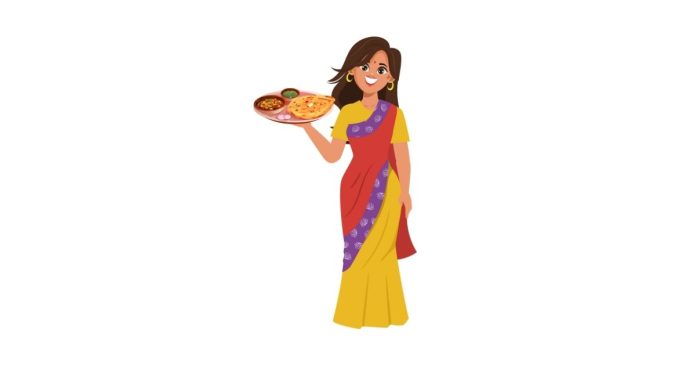Indian cuisine is celebrated around the world for its vibrant flavors, aromatic spices, and unique cooking techniques. But to truly understand the essence of Indian food, it’s important to experience it in its place of origin—India. The diversity of the country’s culture, climate, and traditions is reflected in its food, making it one of the most varied and exciting cuisines in the world.
So, what is Indian food like in India? Let’s explore its rich tapestry.
1. The Diversity of Regional Cuisines
India is a vast country, and its cuisine changes dramatically from region to region. Here’s a quick overview:
- North India: Known for its rich, creamy curries like butter chicken, paneer tikka masala, and dal makhani, North Indian food heavily features wheat-based staples like naan, roti, and paratha. Mughlai influences bring bold flavors, while dishes like biryani and kebabs are popular.
- South India: The South is famous for its rice-based dishes such as dosa, idli, and sambar. Coconut is a common ingredient, and the food is often spicier and tangier. Coastal areas add fresh seafood to the mix.
- East India: This region is known for its love of fish, rice, and mustard. Bengali cuisine stands out for its delicate flavors, with dishes like macher jhol (fish curry) and sweets like rasgulla and sandesh.
- West India: From the fiery curries of Rajasthan to the street foods of Mumbai, Western India offers a range of tastes. Gujarat’s vegetarian dishes like dhokla and the rich seafood of Goa, influenced by Portuguese flavors, make it a culinary hotspot.
Each state—and even city—has its own unique style of cooking, ensuring a new experience wherever you go.
2. Freshness and Use of Local Ingredients
Indian food in India places a strong emphasis on freshness. Vegetables are often sourced from local markets, and spices are ground fresh for each dish. Meals are typically cooked from scratch, and this dedication to freshness enhances the flavors of every dish.
Seasonal ingredients are central to Indian cooking. For example, mangoes dominate summer menus, while winter brings warm, spiced desserts like gajar ka halwa (carrot pudding).
3. The Role of Spices
Indian cuisine is synonymous with spices, but they’re not just about heat. Each spice adds depth, aroma, and character to the dish. Common spices include:
- Turmeric: Adds color and earthy flavor.
- Cumin: Provides a smoky, nutty taste.
- Cardamom: Sweet and aromatic, often used in desserts and curries.
- Chilies: For heat, used in varying degrees depending on the region.
In India, spices are expertly balanced. Dishes are rarely overwhelmingly spicy but instead offer a complex medley of flavors.
4. Street Food Culture
Indian street food is an experience in itself. It’s flavorful, affordable, and perfect for anyone who wants to taste authentic local flavors. Popular street foods include:
- Chaat: A mix of crunchy, tangy, and spicy elements, such as pani puri and bhel puri.
- Vada Pav: Mumbai’s beloved spicy potato sandwich.
- Parathas: Stuffed flatbreads served hot off the griddle.
- Dosas and Idlis: Found in the South, served with tangy chutneys and sambar.
Street food reflects the ingenuity of Indian cooks and the diversity of the country’s palate.
5. Vegetarianism and Non-Vegetarian Delights
India is often seen as a vegetarian paradise. Many dishes are plant-based, with lentils, chickpeas, and vegetables at the forefront. Iconic vegetarian dishes include palak paneer, aloo gobi, and rajma.
That said, non-vegetarian options are equally diverse. From the kebabs of Lucknow to Kerala’s fish curries and Hyderabadi biryani, meat lovers will find plenty to enjoy.
6. Meal Structure and Dining Customs
A traditional Indian meal is often served family-style, with several dishes on the table. It typically includes:
- Staples: Rice or bread (like roti or naan).
- Main Dishes: Curries, lentils, or stir-fried vegetables.
- Sides: Pickles, chutneys, and yogurt (to cool the palate).
- Dessert: Something sweet like gulab jamun, payasam, or kheer.
In many homes, food is eaten with hands, as this is believed to enhance the sensory experience of eating. Sharing meals is a key part of Indian hospitality.
7. Desserts and Sweets
Indian desserts are a celebration of sweetness and often feature milk, sugar, and ghee. Some famous sweets include:
- Laddu: Round, sweet balls made from flour, sugar, and ghee.
- Jalebi: Deep-fried, syrup-soaked spirals.
- Kulfi: Creamy, dense Indian ice cream.
- Gulab Jamun: Deep-fried milk balls soaked in syrup.
Sweets are an integral part of festivals and celebrations in India.
8. Regional Beverages
To complement the food, India offers a variety of drinks, from spiced chai to refreshing lassi. South India is famous for its strong filter coffee, while Northern regions enjoy masala chai with milk and spices. Summer calls for cooling drinks like nimbu pani (lemonade) and sugarcane juice.
Indian food in India is a sensory delight that reflects the country’s diversity and cultural richness. It’s more than just “curry” or “spicy” dishes—it’s a complex and flavorful cuisine shaped by centuries of tradition and regional influences.
From the bustling street food stalls to elaborate home-cooked meals, Indian food is a celebration of flavor, texture, and community. To truly appreciate it, one must experience the local varieties and the stories behind each dish.
Have you ever tried Indian food in India? Share your favorite dishes and experiences in the comments below!



